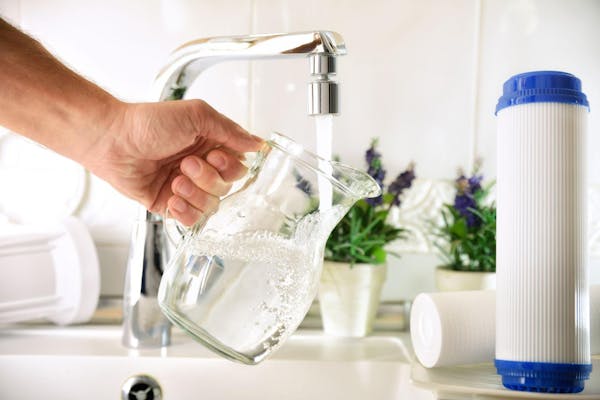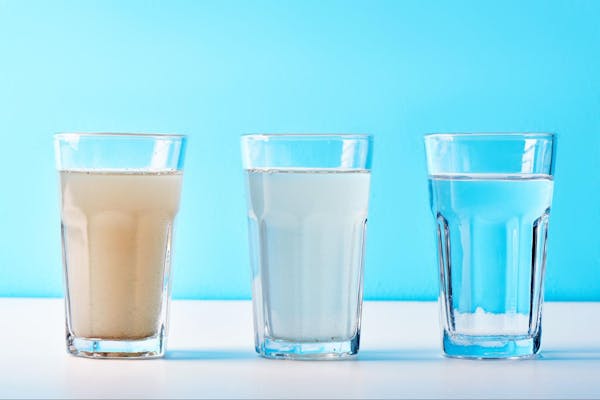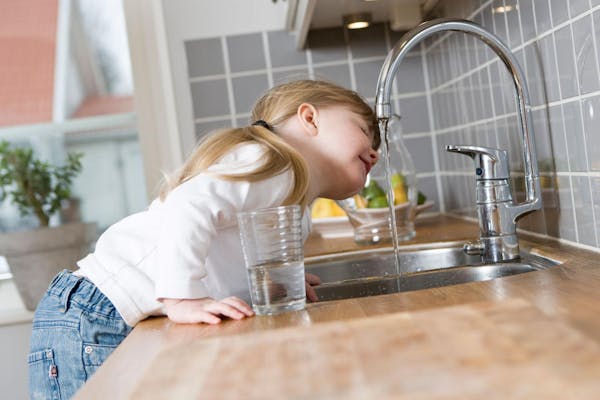May 2025
A Complete Answer to the Water Filter vs. Purifier Debate
When you flip a switch, light comes on. When you turn on a faucet, treated water comes out. It’s something we just expect because, for most people in the U.S. today, we’ve always had it. Yet while the water that comes out of our taps is a modern miracle, it's far from perfect.
Take chlorine, for instance. Chlorine is a very important disinfectant in most water treatment systems. But many people don’t want their drinking water to smell like a swimming pool, nor do they enjoy the drying effect chlorine has on their skin and hair.
Between chlorine and other filterable contaminants that make it to your faucet, it’s no wonder home water filtration is becoming so popular.
It can be a little confusing out there, though. There are so many methods of filtration, and each one is good at removing some pollutants while not being so good at removing others. The marketing jargon doesn’t make it any easier.
The question of water filter vs. purifier is a perfect example. This popular query probably has as many articles that try to answer it as there are people asking it. So why are we bothering to write our own?
Because a lot of what’s out there isn’t quite right, and that can complicate your search for the best water filter for you. So in this article, we want to untangle this question so you can better understand what you should be looking for in a water filtration system.

Which Is Better When It Comes to a Water Filter vs. Purifier?
To figure out which is better, we need to first understand what the terms mean when we say “water filter vs. purifier.” Surprisingly, this is more complicated than it appears on the surface.
When discussing the removal of contaminants from water, there are three concepts that are used interchangeably, even though they mean different things. The concepts are treating water, filtering water, and purifying water.
Purifying water for protection against waterborne illness is something humans have been doing since the dawn of time. We have many ways to treat water so that it’s safe to drink, like:
- Boiling it
- Filtering it through sand or activated carbon
- Running it through a porous rock, cloth, or semipermeable membrane like in reverse osmosis
- Deionizing or using materials that exchange ions with the contaminants
- Using chemical treatments like chlorine
- Distilling it or turning it into steam so it separates from the contaminants
- Exposing it to ultraviolet light
All of these methods are at least somewhat effective at removing or altering impurities in your drinking water, but how effective each method is depends on which impurities you’re trying to remove. For instance, fluoride is only removed through distillation or reverse osmosis, but reverse osmosis filters can be damaged by chlorine, which is easily dealt with by KDF filters.
Reverse osmosis forces water through a semipermeable membrane with very small pores that separate the water from the contaminants. The membrane can be easily damaged or clogged.
What Is the Difference Between a Water Filter and a Water Purifier?
To answer this question, we’re going to use the definitions from the Water Quality Association (WQA). The WQA helps set the standards for water filtration products, including ours.
Water treatment device: “Any point-of-use or point-of-entry device that changes the quality of the water supply by any means, including, but not limited to, filtration, distillation, adsorption, ion exchange, reverse osmosis, or other treatment.” This is a pretty all-encompassing definition. It includes systems usually thought of as filters and those thought of as purifiers. But more on that soon.
Filter: “The process of separating solids from a liquid by means of a porous substance such as a permeable fabric or membrane or layers of inert media.”
Water purifier: There actually is no definition for water purifier or water purification, but there is a definition for purified water. It’s a long one, so I’ll paraphrase it here it’s summarized below.
Purified water is water that meets the standards of the United States Pharmacopeia (USP) for the claim of purified water. The USP sets the standards for purity, strength, and quality for ingredients used to manufacture food and drugs. The standards the USP has set for purified water take into account pH, chloride, sulfate, ammonia, calcium, carbon dioxide, heavy metals, oxidizable substances, total solids, and bacteria levels.
How Is Purified Water Different from Filtered Water?
In the United States, the term “purified water” is strictly defined by the USP and recognized by the Food and Drug Administration.
All water has some impurities, and the human body can deal with a pretty wide range in drinking water. However, the water used in laboratories and in drug manufacturing needs to be tightly controlled and defined.
Contaminants in water can alter the outcome of scientific experiments or change the makeup of a life-saving medication. Having a standard for what can be labeled purified water is necessary for these and other manufacturing processes.
What Methods Can Be Used to Purify Water?
Two of the most popular methods of water treatment that purify water are reverse osmosis and distillation, but any suitable process can be used, according to the USP.
Because of this, if you look up articles about the water filter vs. purifier debate, you’ll likely read that distillation and reverse osmosis systems are water purifiers. This isn’t really true.
While they are often used in the process of creating purified water, just using these processes doesn’t guarantee you’ll reach the clearly defined and regulated standards for purified water.
Getting real purified water is a complex process that requires constant adjustments and maintenance of the systems used. The water is tested often to be sure it’s meeting the standards laid out by the USP.

Are Water Filters and Water Purifiers the Same Thing?
Although “water purifier” can’t be strictly defined, usually when people talk about a purifier they are talking about a distillation system or a reverse osmosis system. These two systems are excellent at removing the smallest of contaminants from your water, which can be left by other filtration methods.
Water filters, on the other hand, are good at removing chlorine and larger particles. Usually, a reverse osmosis (RO) system, which is really just a filtration system with a smaller pore size, will have several stages of pre-filtering before the water reaches the RO membrane. This pre-filtering saves the life of the RO membrane, so it works better and lasts longer.
For instance, the HomeWater 4-Stage Reverse Osmosis Under Counter Under Sink Water Filter has two pre-filter stages. First, water passes through a 5-micron sediment pre-filter to remove dirt, sand, and other physical particulates. Next, the water passes through a pre-carbon filter to protect the RO membrane from free chlorine and sediment.
Once this clean water is forced through the semipermeable membrane to complete reverse osmosis, it finishes by going through a post-carbon filter for a final polishing process. This post filter removes turbidity and ensures only the best quality tap water reaches your glass.
As you can see, the system isn’t one or the other: Filters and purifiers work together to give you crystal-clear, pure water.
Do You Need a Reverse Osmosis Purification System?
There are many types of water filters, and they each work a little differently. Reverse osmosis systems are great, but some people don’t like that they remove fluoride and other minerals. If you want to keep fluoride in your water for your dental health, you’d be better off choosing our EZChange 2-Stage Under Counter Under Sink Water Filter or our 4-Stage Whole Home Filter, which both reduce chlorine, rust, dirt, heavy metals, cysts, and volatile organic compounds (VOCs) but leave the fluoride in your water intact.
Reverse osmosis systems also excel at the removal of:
- Small microorganisms
- Pathogens
- Bacteria like salmonella and E. coli
- Viruses like norovirus and hepatitis A
- Protozoa like giardia and cryptosporidium
They also remove some hard water minerals but aren’t a great solution to hard water overall. Not only do reverse osmosis filters remove fewer mineral solids than a water softener, but the RO membrane could be made less effective and have a shorter lifespan if you don’t soften the water before it reaches the filter.
Should You Be Concerned About Hard Water?
Hard water mineral solids like calcium and magnesium are naturally occurring in most tap water that comes from groundwater sources. This includes about 90% of U.S. households. While harmless to ingest, hard water is known to clog plumbing, damage water-using appliances, leave soap scum that attracts bacteria, and doesn't encourage great hair days.
HomeWater has several solutions for hard water, including traditional and salt-free water softeners.

Should You Use a UV Light to Treat Water?
Ultraviolet light disinfects water by killing living microorganisms in a water source. As water passes under the UV light, the radiation from the light kills biological pathogens like fungi, protozoa, bacteria, and others without adding harmful chemicals.
There are downsides to UV light, though. First, the water needs significant exposure to the UV rays over a period of time. This means the light needs to fully penetrate the water, so murky water may not get much benefit. Small mineral and metal particles, as well as dirt, rust, and sand, can scatter the UV light and provide cover for pathogens—allowing them to survive.
Finally, UV light won’t do anything to remove contaminants that aren’t living, like heavy metals or pesticides.
What Type of Water Filtration System Is Right for You?
There are many types of filtration systems out there. Each will have its benefits and drawbacks. The best way for you to know what type of system you need is to find out what contaminants are in your tap water.
Municipal and city water suppliers put out an annual water quality report showing their results for regulated contaminants. Just remember that some contaminants like PFAs are voluntary to report, and so the presence of these man-made chemicals often won’t be recorded.
If you get water from a private well, it’s a good idea to have your water regularly tested. The Environmental Protection Agency has information on how to get a reliable test.
Once you know what you’re dealing with, no matter if your water comes to you from the city or a private well, we can help determine the right filtration system for you.

Understanding Your Water Filtration Options
The question of water filter vs purifier can be confusing because these terms are often used interchangeably when they mean different things. Understanding the difference can help save you time and frustration when searching for the right water treatment options to suit your needs.
HomeWater is committed to making sure we always have the best options available for providing you with clean, great tasting water you can trust. Our American made 4-Stage Under-Counter Reverse Osmosis Filtration System packs a lot of filter technology into a small under-counter space. It’s also super easy to install and maintain.
Or if you’d rather every tap and appliance in your home covered, check out our Whole House 4-Stage Filtration System with optional water softener for the best possible clean water experience.